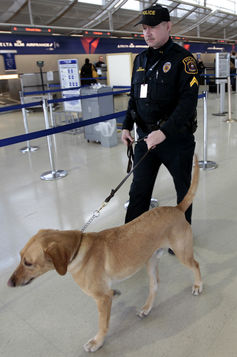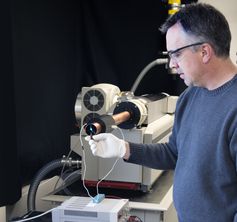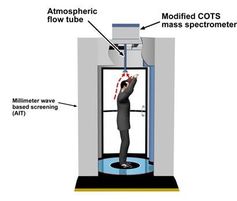
With each terrorist attack on another airport, train station or other public space, the urgency to find new ways to detect bombs before they’re detonated ratchets up.
Chemical detection of explosives is a cornerstone of aviation security. Typically called “trace detection,” this approach can find minuscule amounts of residue left behind after someone handles an explosive. A form of this technology called ion mobility spectroscopy is what Transportation Security Administration officers are using when they swab and test your laptop, hands or other items at the airport. In a few seconds, a sample is vaporized, and the resulting chemical ions are separated by molecular size and shape, triggering an alarm if an explosive compound is detected.
But this method is labor-intensive and slow for large volumes of stuff, and its effectiveness can depend on the sampling skill of the officer. It relies on contact sampling, which requires security personnel to have access to surfaces where residue may have been left. That’s not useful if a bomber has no intention of going through a security line and having his personal effects searched.

Some security teams rely on dogs, which can be trained to sniff out explosives using their exquisite sense of smell. But the logistics and training involved with the routine deployment of canines can be arduous, and there are cultural barriers to using dogs to directly screen people.
What researchers have wanted to develop for a long time is a new chemical detection technology that could “sniff” for explosives vapor, much like a canine does. Many efforts over the years fell short as not being sensitive enough. My research team has been working on this problem for nearly two decades – and we’re making good headway.
More and more sensitive
The one big hurdle to engineering some kind of technology to rival a dog’s nose is the extremely low vapor pressures of most explosives. What we call the “equilibrium vapor pressure” of a material is basically a measure of how much of it is in the air, available for detection, under perfect conditions at a specific temperature.
Commonly used by military forces around the world, nitro-organic explosives such as TNT, RDX and PETN have equilibrium vapor pressures in the parts per trillion range. To reliably sniff out related vapors in operational environments, like a busy check-in area of an airport, the detection capability would need to be well below that – down into the parts per quadrillion range for many explosives.
These levels have been beyond the capability of trace detection instrumentation. Achieving a 325 parts per quadrillion level of detection is analogous to finding one specific tree on the entire planet Earth.
But recent research has pushed the detection envelope into that part-per-quadrillion range. In 2008, an international team used an advanced ionization technique, called secondary electrospray ionization mass spectrometry, to get better than part per trillion level detection of TNT and PETN.
In 2012, our research team at Pacific Northwest National Laboratory (PNNL) achieved direct, real-time detection of RDX vapors at levels below 25 parts per quadrillion using atmospheric flow tube mass spectrometry (AFT-MS).

Sensitivity for a mass spectrometer is related to how many of the target molecules can be ionized and transferred into the mass spectrometer for detection. The more complete that process is, the better sensitivity will be. Our AFT-MS scheme is different because it uses time to maximize the benefits of the collisions of the explosive vapor molecules with air ions created from the ion source. It is the extent of reaction between the created ions and the explosives molecules that defines the sensitivity. Using AFT-MS, we’ve now expanded the capability to be able to detect a suite of explosives at single-digit part per quadrillion level.
Next step: putting it into practice
So we’ve moved the state of the art of chemical-based explosives detection into a realm where contact sampling is no longer necessary and instruments can “sniff” for explosives in a manner similar to canines.

Instruments that have the vapor detection capability of canines and can also operate continuously open up exciting new security screening possibilities. Trace detection wouldn’t need to rely on direct access to suspicious items for sampling. Engineers could create a noninvasive walk-through explosive detection device, similar to a metal detector.
The real innovation is in the direct detection of the vapor plume, enabled by the extreme sensitivity. There is no longer a need to collect explosive particles for vaporization – as is the case in past trace detection technologies that use loud air jets to dislodge particles from people. Instead, the greater sensitivity means the air could simply be constantly sampled for explosives molecules as people pass through.
This approach would certainly make airport checkpoints less onerous, improving throughput and the passenger experience. These types of devices could also be set up at entrances to airport terminals and other public facilities. It would be a major security leap to be able to detect explosives that are entering a building, not only when passing through a checkpoint.

A deployed vapor detection capability would also increase safety by adding a second independent form of information to what scanners have available. Currently, most screening techniques, such as x-ray and millimeter wave imaging, are based on spotting anomalies – a TSA operator notices a strange shape in the image. A vapor detection technology would add to their toolkit the ability to identify specific chemicals.
It allows for a two-pronged approach to finding explosives: spotting them on an image and sniffing them out in the vapor plume emitted by a checked bag or a person. It’s like recognizing a person you know but haven’t seen in a long time; both seeing a recent picture and hearing their voice may be necessary to identify them, rather than just one of those pieces of information on its own.
Inspired by the tremendous detection capabilities of dogs, we’ve made remarkable advances toward developing technology that can follow in their footsteps. Deploying vapor analysis for explosives can both enhance security levels and provide a less intrusive screening environment. Continuing research aims to hone the technology and lower its costs so it can be deployed at an airport near you.![]()
David Atkinson, Senior Research Scientist, Pacific Northwest National Laboratory
This article was originally published on The Conversation. Read the original article.

